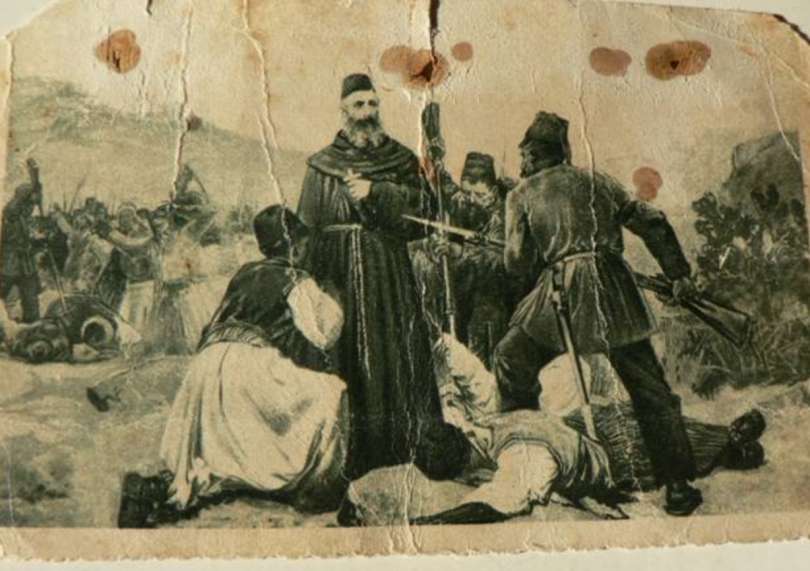

The martyrdom of Father Salvatore Lilli
Photo: cappadociawebmarsica.blogspot.com
CAPPADOCIA , December 05, 2022 / 6:00 PM (ACI Press).-
Cappadocia it is not only the name of a region located in the heart of the Anatolian peninsula, straddling Asia Minor and Mesopotamia, but it is also an Abruzzo village not too far from the two major centers of Marsica, Avezzano and Tagliacozzo.
On June 19, 1853, the Franciscan missionary father in the Holy Land was born here, Salvatore Lilli, who was martyred in Turkey during the Armenian Genocide on November 22, 1895whose anniversary fell just in these days.
The cause for beatification of Father Salvatore and his fellow Armenians who suffered martyrdom with him was introduced at the S. Congregation of Rites on February 13, 1959. Subsequently, they were beatified by Pope John Paul II on October 3, 1982.
Just recently, at the end of October, the habit of the martyred religious returned to his native town, precisely Cappadocia, as the major Abruzzo newspaper, il Centro, informs us. Welcomed in the church of Santa Margherita in Cappadocia with a function presided over by the bishop of the diocese of Avezzano, Monsignor Giovanni Massaro, he now remains entrusted to the diocese of Avezzano. The relic had been donated to the minister of the Province of San Bonaventura of the Franciscan friars minor, Luciano De Giusti, by the minister of the Province of the Immaculate Conception in Spain, Joaquin Zurera Ribò.
As custodian of the relic, Msgr. Massaro ordered that the habit belonging to the martyr be permanently exhibited for public worship and the veneration of the faithful in the parish of Cappadocia.
“A historic and solemn day for our community – commented the mayor Lorenzo Lorenzin – our blessed Salvatore Lilli has returned home. It was an honor to represent my entire community in such a touching moment of great spirituality between sacredness, devotion and pride”.
Wearing the Franciscan habit in July 1870, Salvatore Lilli made his religious profession in August 1871 and due to the suppression of religious orders, Salvatore of Cappadocia, this is his religious name, was sent to Palestine in 1873, first to Bethlehem and then in Jerusalem where he was ordained a priest on April 6, 1878.
After two years he was transferred to Armenia Minor where he exercised his apostolate for 15 years. In 1890 he did his utmost to help the sick affected by the cholera epidemic and in 1894 he was appointed parish priest and superior of the Mugiukderesi hospice. Here, on 22 November 1895, at the outbreak of political revolts and with the Turks protagonists of terrible massacres, he was arrested with twelve other Christians to be taken to Marasc. During the journey he was asked to renounce the faith and was killed when he refused. He was beatified by John Paul II on October 3, 1982.
The Holy Land Almanac of Fr. Franciscans of Jerusalem (pp. 26-29) points out how the good Father has always refused to abandon his flock to save himself. As we have mentioned, when the massacres began the future martyr was in Mugiukderesi, a dangerous place above all others, so much so that the
Franciscan religious of Maraasc, fearing for his life, strongly pressured him to go and stay with them. And the religious of Jenigekalé sent a messenger three times in the same day to beg him to flee with them. But Fr Salvatore didn’t want to hear about it. “Where the sheep are, there must remain the shepherd”, he replied. Even his parishioners, when they realized that the troops were about to arrive in Mugiakderesi, begged the Missionary with folded hands to mount his horse and leave the village to save himself.
He was adamant. It seemed to him indecorous, unworthy of a soldier of Christ and of a son of the great Franciscan family, to go away in those moments of danger. Certainly in those days, while pressures and threats pressed on him from all sides, the large group of his brother martyrs passed jubilantly before his gaze, urging him to fulfill his duty. He certainly thought back to the struggles, to the blood that always cost the Franciscans the conservation of that Land made sacred by the life of the Man-God. And therefore he did not move: and “an intrepid and combative man” he wanted to face the danger in order to share the fate of his parishioners and assist them to the last.
The prayers of relatives, confreres and friends were also useless, as they tried by all means to convince him to stay in Italy, the only time he had returned there to see his loved ones after 16 years, in 1886. He wanted to return in the East, which had a secret, mysterious attraction for him! It seemed that to him, as a just heir, the Seraphic Father had transmitted that ardent desire for martyrdom which he had not been able to satisfy.
In the summer of 2021 a virtual pilgrimage was organized in the footsteps of the Blessed, and in 2022 the event took the form of a conference to present his rich epistolary to his sister, Sister Maria Pia Lilli, a Trinitarian nun. It is a work resulting from the active collaboration of several actors: in addition to the Trinitarian nuns, who patiently and diligently transcribed all the letters from the original, the drafting of the work was supervised by Father Claudio Bottini ofm, of the Studium Biblicum of Jerusalem, and Don Enzo Massotti, a native priest of Cappadocia, then provided for the introduction and notes, to facilitate reading by contextualizing each reference reported for each letter. In addition to being spiritual director at the Chieti seminary, Don Massotti is the author of a concise biography of the “Blessed Salvatore Lilli priest, Franciscan, martyr” released in the first edition in January 2022.
Savior of Cappadocia the saint from Abruzzo who died for the Armenian people

